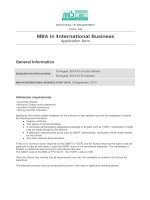International business 7e czinkota moffett ch13
Bạn đang xem bản rút gọn của tài liệu. Xem và tải ngay bản đầy đủ của tài liệu tại đây (797.85 KB, 21 trang )
Chapter 13
Organization,
Implementation, and
Control
1
Learning Objectives
Describe alternative organizational
structures for international
operations.
Highlight factors affecting decisions
about the structure of international
organizations.
Indicate roles for country organizations
in the development of strategy and
implementation of programs.
Outline the need for and challenges of
controls in international operations.
2
Organizational Structure
Companies must change strategies as their
structures evolve from domestic to multinational.
The basic functions of an organization are to
provide:
A route and locus of decision making
and coordination.
A system for reporting and
communications.
3
Organizational Designs
Types of structures used by companies to manage
foreign activities:
Little/No
Little/NoFormal
Formal
Organization
Organization
International
InternationalDivision
Division
Global
GlobalOrganizations
Organizations
4
Little or No Formal Organization
Domestic operations assume
responsibility for international
activities in the early stages.
The organizational structure
reflects the increased
demands from the
international marketplace.
The export department
structure becomes obsolete as
the firm becomes more
involved in foreign markets.
5
The International Division
Centralizes in one entity
all of the responsibility
for international
activities.
Best serve firms with
few products that do not
vary significantly.
Coordination is
important.
6
Global Organizational Structures
Types:
Product Structure
Area Structure
Most often used by
multinational
corporations.
Improved cost
efficiency is a major
benefit.
Second most used
approach. Follows
the marketing
concept most
closely.
7
Global Organizational Structures
(continued)
Types:
Functional
Structure
Customer
Structure
The simplest from
the administrative
viewpoint. A
variation is one that
uses processes as a
basis for structure.
Especially used if
customer groups
are dramatically
different.
8
Global Organizational Structures
(continued)
Types:
Mixed Structure
Matrix Structure
Combines two or
more organizational
dimensions
simultaneously.
Integrates the
various approaches.
Most companies find
this arrangement
problematic.
Complexity of this
structure may
increase the reaction
time of a company.
9
Implementation
Locus of Decision Making
Decentralized systems have loose and
simple controls. Subsidiary operates
as a profit center.
Centralized systems have tight
controls.
Strategic decision making is at
headquarters.
Coordinated decentralization calls for
overall strategy to come from
headquarters.
Subsidiaries are free to implement
within
agreed upon range.
10
Decision Making
Factors that impact structure and decision making.
Degree of involvement in
international
operations.
Products that the firm markets.
Size and importance of the firm’s
markets.
Human resource capability of the
firm.
11
The Networked Global Organization
The network avoids
problems of effort
duplication, inefficiency,
and resistance to ideas.
Subsidiaries are able to
make local business
development decisions
within the global
framework.
12
Internal Cooperation
Success for a global firm involves
the ability to move intellectual
capital.
Boundarylessness describes a
situation in which people can act
without regard to status while
feeling the freedom to search
elsewhere for innovative ideas.
International teams promote
cooperation.
13
Internal Cooperation
(contd.)
Greatly assisted
by Internetbased
technology.
Access to virtual
teams.
14
Roles:
Country Organizations
Stra
tegic
Contributor
Lead
Implementor
er
le
o
H
k
Blac
15
Country Organizations
Strategic Leader
A competent national subsidiary that may be
serving as a partner in developing and
implementing strategy.
Contributor
Country organization with a distinctive
competence.
16
Country Organizations
Implementor
Most entities hold this role. It
provides critical mass for the global effort.
Black Hole
The international company has a
low
competence country organization,
or
none at all.
17
Controls
Internal benchmarking is of great importance in
today’s market.
General instruments of control:
Bureaucratic/Formalized Control
Cultural Control
18
The Bureaucratic/Formalized
Control System
Elements:
International budget and
planning system.
Functional reporting
system.
Policy manuals to direct
functional performance.
19
Cultural Control
Requires personal
interaction.
Requires careful
selection and
training of
corporate
personnel.
20
Exercising Controls
Manufacturing subsidiaries tend to be controlled
more intensively than sales subsidiaries.
U.S.-based multinationals place more emphasis
on quantitative data.
Control systems must consider the impact of the
environment.
21









